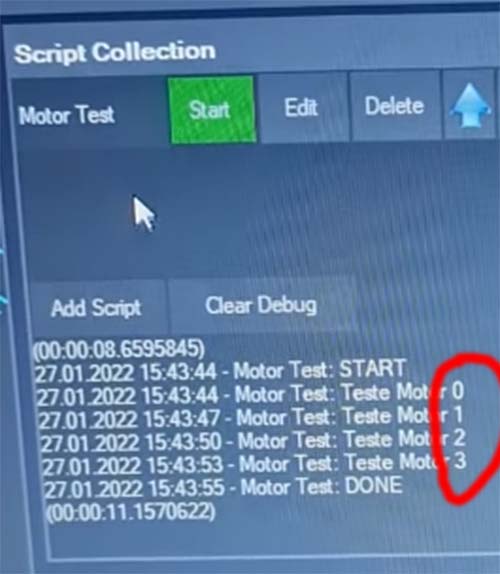Knusel
This Video Show my problems
I have problems with my hexapod. The robot makes uncontrolled movements every time the ezb is restarted. (as soon as I control a motor)
Or as soon as the engines need power. With both, it always ends with the ezb restarting. Now I don't know exactly where the problem lies. I suspect servos or voltage. I'm currently using a power bank (9v 3a), but I've also tried a power supply (also 9v 3a) with the same result.
But the same problem also occurs with another robot of mine, where I use a different ezb and different servos.
Am I doing something fundamental wrong? or is the ezb just suitable for small robots with small motors?
I Used this servos:
https://www.amazon.de/dp/B07T756ZYC/ref=cm_sw_r_apan_glt_i_S26QNBSS312FF2Y1XE00?_encoding=UTF8&psc=1
all servos work individually. (Apart from the fact that they move uncontrollably for a short time when they are controlled for the first time)

Bookmarked that page for reference!
hi all
looks like the servo's are not calibrated and the init script is not in the start up connection window. seems the servo's is trying to go further then possible . is there a servo profile ?

That's what I actually wanted to do with the script first. But I had the same problem: Only servos that I had already moved manually moved. But I will test it again and report back here.But I'm not getting my hopes up any more, I think I completely underestimated the power consumption.
But where can I get Lipos or batteries or power supplies with more like 3A at 9V? I can't find anything there.
I'm currently using this: https://www.amazon.de/gp/product/B089SQFCBW/ref=ppx_yo_dt_b_asin_title_o03_s00?ie=UTF8&th=1
But as I said, I've already tested it with a power supply.
no, there is no servo profile, unfortunately I have not yet fully understood what it is used for. I thought it was just for fine tuning?I am happy to accept links for information on the subject ;-)
But the main question is probably where can I get a (mobile) power source with more than 3A
Thank you for all replies. I'm actually a bit disappointed, because of course it wasn't cheap and now the project seems to fail due to too few amps...
what servo's are you using and what voltage does they recomend ?
The servos you are using are rated best for 6.8v, so you'd want a 7.4v lipo.
The thing about amperage with batteries is different than a power supply. Here is why - a power supply has a limit of current it can produce (i.e., 3amps). However, a battery has an additional rating called a C rating. That rating is the capacity of energy the battery can safely discharge, represented as a multiple of its overall capacity. A battery with a higher C rating delivers more energy, which means higher performance.
Batteries are rated in milliamp per hour. So they can provide X amount of milliamps in an hour. If your battery was 5,000 mAh and you were drawing 1,000mAh continuously, your battery would theoretically last 5 hours. Also, if your robot were drawing 5,000 mAh, then your battery would last 1 hour.
However, the C rating means that your battery can discharge more current than the mAh rating. You see, the battery has a 5,000 mAh capacity, but if you were to draw 10,000 mAh, then the battery would last 30 minutes. So a 5,000 mAh battery does not mean that is the maximum output - it means that is the current per hour.
So a higher C rating means that a 7.4v 5200 mAh lipo battery can deliver 10 continuous amps for 30 minutes. However, the servos will light on fire if they draw 10 amps of current. The current when the servos are not moving is minimal.
Here's a good lipo battery for your application: https://www.amazon.ca/RoaringTop-5200mAh-Battery-Connector-Truggy/dp/B08G1H8HMB
BTW, that hexapod is going to be super cool. I made a large one that I named Super Six.
I used the servo mapping and Auto Position GAITs from the Six project here: https://synthiam.com/Community/Apps/Six-Bare-10964
Not sure if that Auto Position GAIT will be helpful to your robot configuration or not. You'd have to make sure the servos are connected in the same orientation, but other than that, maybe it'll be helpful.
hi dj / knusel
here (s the link for calibrating your servo's . after that you can use servo profile . calibrate the servo's whit no bracket attached so the horn can move to 90 , then ad the bracket and do fine tunning . you can find all info on ez robots.com .
lessons robot
Nomad, knusel won't have a reason to calibrate the servos if he's programming the gait from scratch. However, if he does use the project I referenced in my previous post, he may need to tweak the servo positions with a calibration. Or he can modify the Auto Position gait frames.